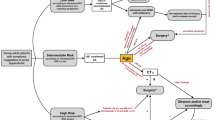Abstract
Background
Single-incision pediatric endosurgical (SIPES) appendectomy has been reported in few pediatric surgical centers. We have adopted the technique recently and have offered it to all patients in whom appendectomy was indicated. The purpose of this study was to report our experience with SIPES appendectomy for acute appendicitis, perforated appendicitis, and interval appendectomy, and to compare the results with those from patients who underwent conventional laparoscopic appendectomy 1 year previously.
Methods
After IRB approval, data on all SIPES appendectomies performed in our hospital were prospectively collected, including operative time, intra- and postoperative complications, conversion rate, blood loss, and hospital length of stay. Cases were stratified into three categories: acute appendicitis, perforated appendicitis, and interval appendectomy. They were compared to patients operated on in 2007 using conventional laparoscopic (three-trocar) appendectomy.
Results
During the study period, 75 SIPES appendectomies were undertaken. Mean age was 11 years (range = 2-19 years) and mean weight was 45 kg (range = 12-132 kg). All SIPES appendectomies were completed laparoscopically, and additional trocars were placed in 20% of cases. SIPES interval appendectomies took the longest and had the highest conversion rate (33%). Follow-up data was available in 63 patients (82%) at a median of 3 weeks. There were three wound infections in the SIPES group (4%) and one in the 151 control patients. Compared to historic controls, operative time was shorter with SIPES compared to conventional laparoscopy for acute appendicitis (37 ± 12.3 vs. 44.1 ± 20.3 min, p = 0.01, 95% CI = 32–42 min).
Conclusion
SIPES appendectomy is a very good alternative to the conventional laparoscopic approach, especially for acute appendicitis. It is technically more challenging for perforated appendicitis and interval appendectomy. Yet, with appropriate consideration and skill, scarless appendectomy is achievable.
Similar content being viewed by others
References
Wang X, Zhang W, Yang X, Shao J, Zhou X, Yuan J (2009) Complicated appendicitis in children: is laparoscopic appendectomy appropriate? A comparative study with the open appendectomy—our experience. J Pediatr Surg 44:1924–1927
Pelosi MA, Pelosi MA III (1992) Laparoscopic appendectomy using a single umbilical puncture (minilaparoscopy). J Reprod Med 37:588–594
Valla J, Ordorica-Flores RM, Steyaert H, Merrot T, Bartels A, Breaud J, Ginier C, Cheli M (1999) Umbilical one-puncture laparoscopic-assisted appendectomy in children. Surg Endosc 13:83–85
Ponsky TA, Diluciano J, Chwals W, Parry R, Boulanger S (2009) Early experience with single-port laparoscopic surgery in children. J Laparoendosc Adv Surg Tech A 19:551–553
Rothenberg SS, Shipman K, Yoder S (2009) Experience with modified single-port laparoscopic procedures in children. J Laparoendosc Adv Surg Tech A 19(5):695–698
Dutta S (2009) Early experience with single incision laparoscopic surgery: eliminating the scar from abdominal operations. J Pediatr Surg 44:1741–1745
Olympus Europa Holding GmbH (2009) Potential benefits in LESS surgery. http://www.olympus-europa.com/less/Default_6137.aspx. Accessed 19 Nov 2009
Meguerditchian AN, Prasil P, Cloutier R, Leclerc S, Péloquin J, Roy G (2002) Laparoscopic appendectomy in children: a favorable alternative in simple and complicated appendicitis. J Pediatr Surg 37:695–698
Taqi E, Al Hadher S, Ryckman J, Su W, Aspirot A, Puligandla P, Flageole H, Laberge JM (2008) Outcome of laparoscopic appendectomy for perforated appendicitis in children. J Pediatr Surg 43:893–895
Ikeda H, Ishimaru Y, Takayasu H, Okamura K, Kisaki Y, Fujino J (2004) Laparoscopic versus open appendectomy in children with uncomplicated and complicated appendicitis. J Pediatr Surg 39:1680–1685
Tracy CR, Raman JD, Bagrodia A, Cadeddu JA (2009) Perioperative outcomes in patients undergoing conventional laparoscopic versus laparoendoscopic single-site pyeloplasty. Urology 74:1029–1034
Fishman SJ, Pelosi L, Klavon SL, O’Rourke EJ (2000) Perforated appendicitis: prospective outcome analysis for 150 children. J Pediatr Surg 35:923–926
Disclosures
Drs. Muensterer, Puga Nougues, Adibe, Georgeson, and Harmon, and Mrs. Amin have no conflicts of interest or financial ties to disclose.
Author information
Authors and Affiliations
Corresponding author
Rights and permissions
About this article
Cite this article
Muensterer, O.J., Puga Nougues, C., Adibe, O.O. et al. Appendectomy using single-incision pediatric endosurgery for acute and perforated appendicitis. Surg Endosc 24, 3201–3204 (2010). https://doi.org/10.1007/s00464-010-1115-x
Received:
Accepted:
Published:
Issue Date:
DOI: https://doi.org/10.1007/s00464-010-1115-x




